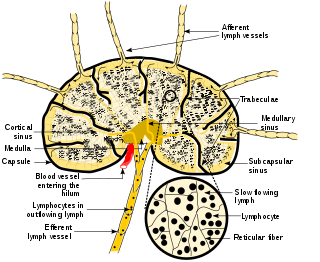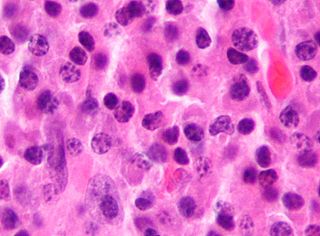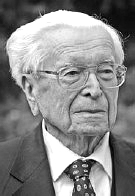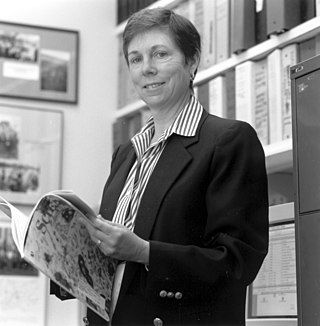Related Research Articles

Lymphoma is a group of blood and lymph tumors that develop from lymphocytes. The name typically refers to just the cancerous versions rather than all such tumours. Signs and symptoms may include enlarged lymph nodes, fever, drenching sweats, unintended weight loss, itching, and constantly feeling tired. The enlarged lymph nodes are usually painless. The sweats are most common at night.

The lymphatic system, or lymphoid system, is an organ system in vertebrates that is part of the immune system, and complementary to the circulatory system. It consists of a large network of lymphatic vessels, lymph nodes, lymphoid organs, lymphoid tissues and lymph. Lymph is a clear fluid carried by the lymphatic vessels back to the heart for re-circulation..

A lymph node, or lymph gland, is a kidney-shaped organ of the lymphatic system and the adaptive immune system. A large number of lymph nodes are linked throughout the body by the lymphatic vessels. They are major sites of lymphocytes that include B and T cells. Lymph nodes are important for the proper functioning of the immune system, acting as filters for foreign particles including cancer cells, but have no detoxification function.

Tumors of the hematopoietic and lymphoid tissues or tumours of the haematopoietic and lymphoid tissues are tumors that affect the blood, bone marrow, lymph, and lymphatic system. Because these tissues are all intimately connected through both the circulatory system and the immune system, a disease affecting one will often affect the others as well, making aplasia, myeloproliferation and lymphoproliferation closely related and often overlapping problems. While uncommon in solid tumors, chromosomal translocations are a common cause of these diseases. This commonly leads to a different approach in diagnosis and treatment of hematological malignancies. Hematological malignancies are malignant neoplasms ("cancer"), and they are generally treated by specialists in hematology and/or oncology. In some centers "hematology/oncology" is a single subspecialty of internal medicine while in others they are considered separate divisions. Not all hematological disorders are malignant ("cancerous"); these other blood conditions may also be managed by a hematologist.
The Working formulation is an obsolete classification of non-Hodgkin lymphomas, first proposed in 1982. It has since been replaced by other lymphoma classifications, the latest published by the WHO in 2016 but is still used by cancer agencies for compilation of lymphoma statistics.
Nancy Lee Harris is an educator as well as a well-established medical professional. She currently serves as a professor of pathology at Harvard Medical School. She is also a physician at Massachusetts General Hospital and an editor with the New England Journal of Medicine. She was trained at multiple different hospitals; however, the majority of her adult life has been spent working in Boston, Massachusetts. Throughout her life she has held many notable positions including but not limited to: Director of Hematopathology, Director of Surgical Pathology, Director of Anatomic Pathology, Director of Anatomic and Clinical Pathology Residency Program, and Director of Hematopathology Fellowship Program. Harris is an important and distinguished medical provider in the Greater Boston area and focuses her research on blood malignancies and lymphoid neoplasms.
Clara Derber Bloomfield, was an American physician and cancer researcher. Her work focused on the genetic changes that are present in certain types of blood cancers, and how those can be utilized to improve treatment for the affected patients.
Robert Collins (1928-2013) was an American physician and pathologist, who worked for his entire career at Vanderbilt University.

Karl Lennert, M.D. was a German physician and pathologist.
Ventana Medical Systems, Inc. was a medical device company that develops, manufactures, and markets instrument reagent systems that automate tissue and slide staining in anatomic pathology laboratories. These products assist in the diagnosis and treatment of cancer and infectious diseases.

Elaine Sarkin Jaffe is a senior National Cancer Institute (NCI) investigator at the National Institutes of Health (NIH) most well known for her contribution to hematopathology. She completed her medical education at Cornell University and the University of Pennsylvania, receiving her M.D. degree from University of Pennsylvania in 1969. After an internship at Georgetown University she joined NCI as a resident in anatomic pathology, and has been a senior investigator since 1974, focusing on the classification and definition of lymphomas. Jaffe's early work helped to provide a deeper understanding of the origin of lymphomas, especially follicular lymphoma. Her team notably elucidated the difference between T cell and B cell lymphomas.
Primary cutaneous follicle center lymphoma is a type of lymphoma. It was recognized as a distinct disease entity in the 2008 WHO classification. PCFCL had been previously conceived as a variant of follicular lymphoma (FL).
ALK+ large B-cell lymphoma is a type of lymphoma. It was first reported in 1997. It is a rare, aggressive large B-cell process that shows ALK expression. It is distinct from anaplastic large cell lymphoma, a T-cell lymphoma.
Large B-cell lymphoma arising in HHV8-associated multicentric Castleman's disease is a type of large B-cell lymphoma, recognized in the WHO 2008 classification. It is sometimes called the plasmablastic form of multicentric Castleman disease. It has sometimes been confused with plasmablastic lymphoma in the literature, although that is a dissimilar specific entity. It has variable CD20 expression and unmutated immunoglobulin variable region genes.
Epstein–Barr virus positive diffuse large B-cell lymphoma, not otherwise specified was initially termed in the WHO 2008 classification as Epstein–Barr virus-positive DLBCL of the elderly because it was a specific type of large B-cell lymphoma that appeared to be limited to elderly individuals. Since this 2008 WHO classification, however, the disorder has been diagnosed in much younger adults and children. Accordingly, the WHO classification of 2016 renamed this order as EBV+ DLBCL, NOS. The disease is also classified as one of numerous related and interrelated Epstein-Barr virus-associated lymphoproliferative diseases.
Primary mediastinal (thymic) large B-cell lymphoma is a distinct type of diffuse large B-cell lymphoma involving the mediastinum, recognized in the WHO 2008 classification.
Richard Anthony Scolyer is an Australian pathologist. He is a senior staff specialist in tissue pathology and diagnostic oncology at Royal Prince Alfred Hospital, co-medical director at the Melanoma Institute Australia, and Cojoint professor at the University of Sydney.

Sarah Coupland is an Australian-born pathologist and professor who is the George Holt Chair in Pathology at the University of Liverpool. Coupland is an active clinical scientist whose research focuses on the molecular genetics of cancers, with particular interests in uveal melanoma, conjunctival melanoma, intraocular and ocular adnexal lymphomas and CNS lymphoma. Coupland is also an NHS Honorary Consultant Histopathologist at the Royal Liverpool University Hospital. Since 2006, Coupland has been head of the Liverpool Ocular Oncology Research Group; from which she runs a multidisciplinary oncology research group focussing on Uveal melanoma, based in the Department of Molecular and Clinical Cancer Medicine at the University of Liverpool. Her research laboratory is currently located in the Institute of Translational Medicine From April 2014 to December 2019, Coupland was also Director of the North West Cancer Research Centre, @UoL. In both 2019 and 2020, Coupland was included on the 'Pathology Powerlist' on The Pathologist website.
Mature T-cell lymphoma, also called peripheral T-cell lymphoma, is a group of rare, aggressive lymphomas that develop from mature white blood cells and originate from lymphoid tissues outside of the bone marrow. Mature T-cell lymphoma is under the category of non-Hodgkin lymphoma. Mature T-cell lymphomas account for 10% to 15% of all lymphomas and is more common in Asia than in Europe and America. Its common subtypes include angioimmunoblastic T-cell lymphoma, anaplastic large cell lymphoma and peripheral T-cell lymphoma not otherwise specified. While different subtypes have variable symptoms, common symptoms include enlarged painless lymph nodes, fever, weight loss, rash and night sweats.
Dennis Howard Wright was a British medical doctor and professor of pathology with an international reputation in haematopathology.
References
- 1 2 3 "Thomas Grogan, M.D." University of Arizona. Retrieved 2013-01-31.
- 1 2 3 4 5 "Ventana Appoints Dr. Thomas Grogan Chief Scientific Officer & Medical Director". PR Newswire. Retrieved 2013-01-31.
- ↑ "Conquering Cancer". BizTucson. Archived from the original on 2013-04-10. Retrieved 2013-01-31.
- ↑ Pileri, SA; Grogan, TM; Harris, NL; Banks, P; Campo, E; Chan, JK; Favera, RD; Delsol, G; De Wolf-Peeters, C; Falini, B; Gascoyne, RD; Gaulard, P; Gatter, KC; Isaacson, PG; Jaffe, ES; Kluin, P; Knowles, DM; Mason, DY; Mori, S; Müller-Hermelink, HK; Piris, MA; Ralfkiaer, E; Stein, H; Su, IJ; Warnke, RA; Weiss, LM (July 2002). "Tumours of histiocytes and accessory dendritic cells: an immunohistochemical approach to classification from the International Lymphoma Study Group based on 61 cases". Histopathology. 41 (1): 1–29. doi:10.1046/j.1365-2559.2002.01418.x. PMID 12121233. S2CID 32370765.
- ↑ "Trying to save 8 million people, starting with his wife". Tucson News Now. 2012-10-01. Retrieved 2013-01-31.
- ↑ WHO Classification of Tumours of Haematopoietic and Lymphoid Tissue (IARC WHO Classification of Tumours). Lyon: International Agency for Research on Cancer, World Health Organization. 2008. ISBN 9789283224310.